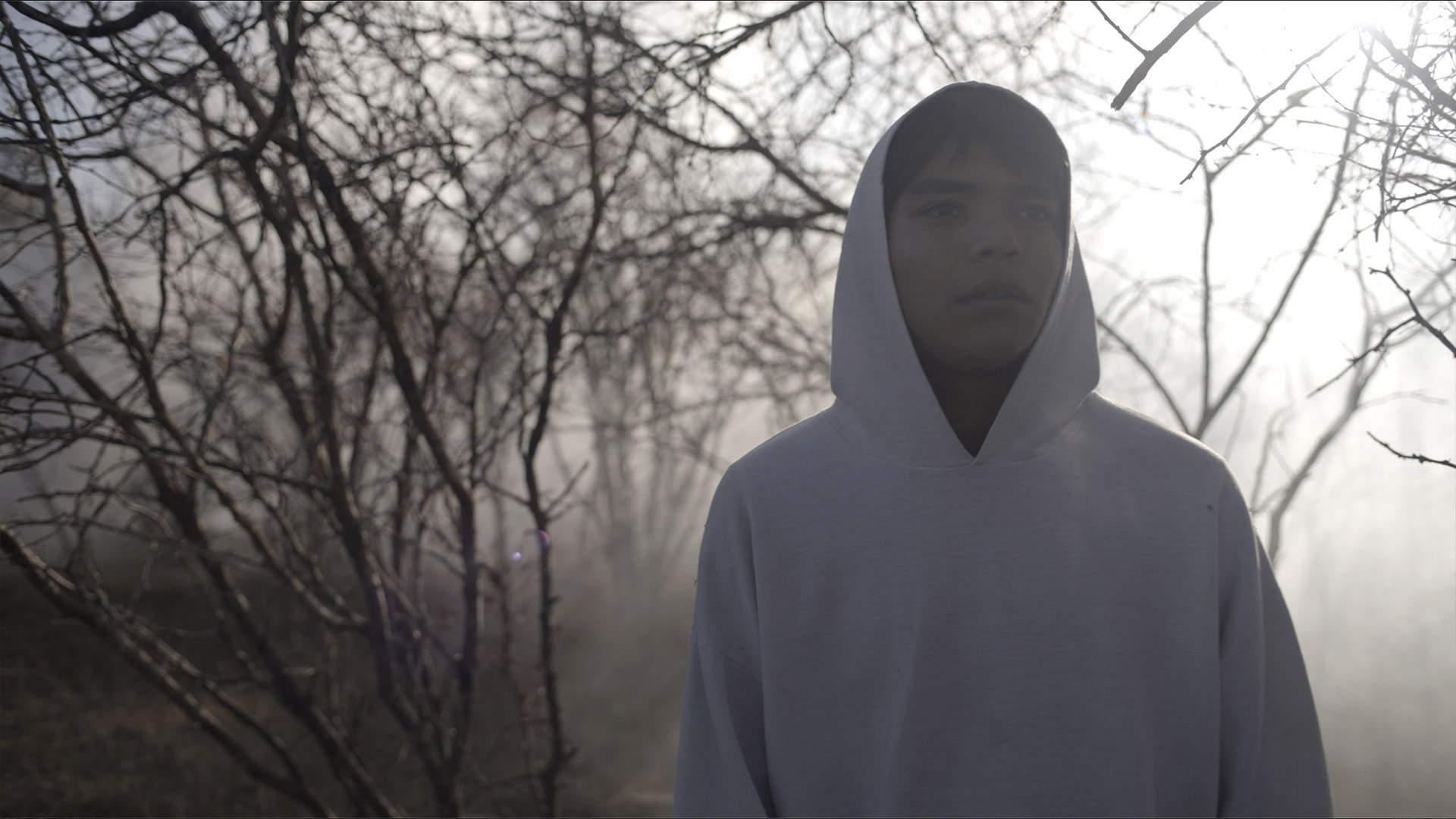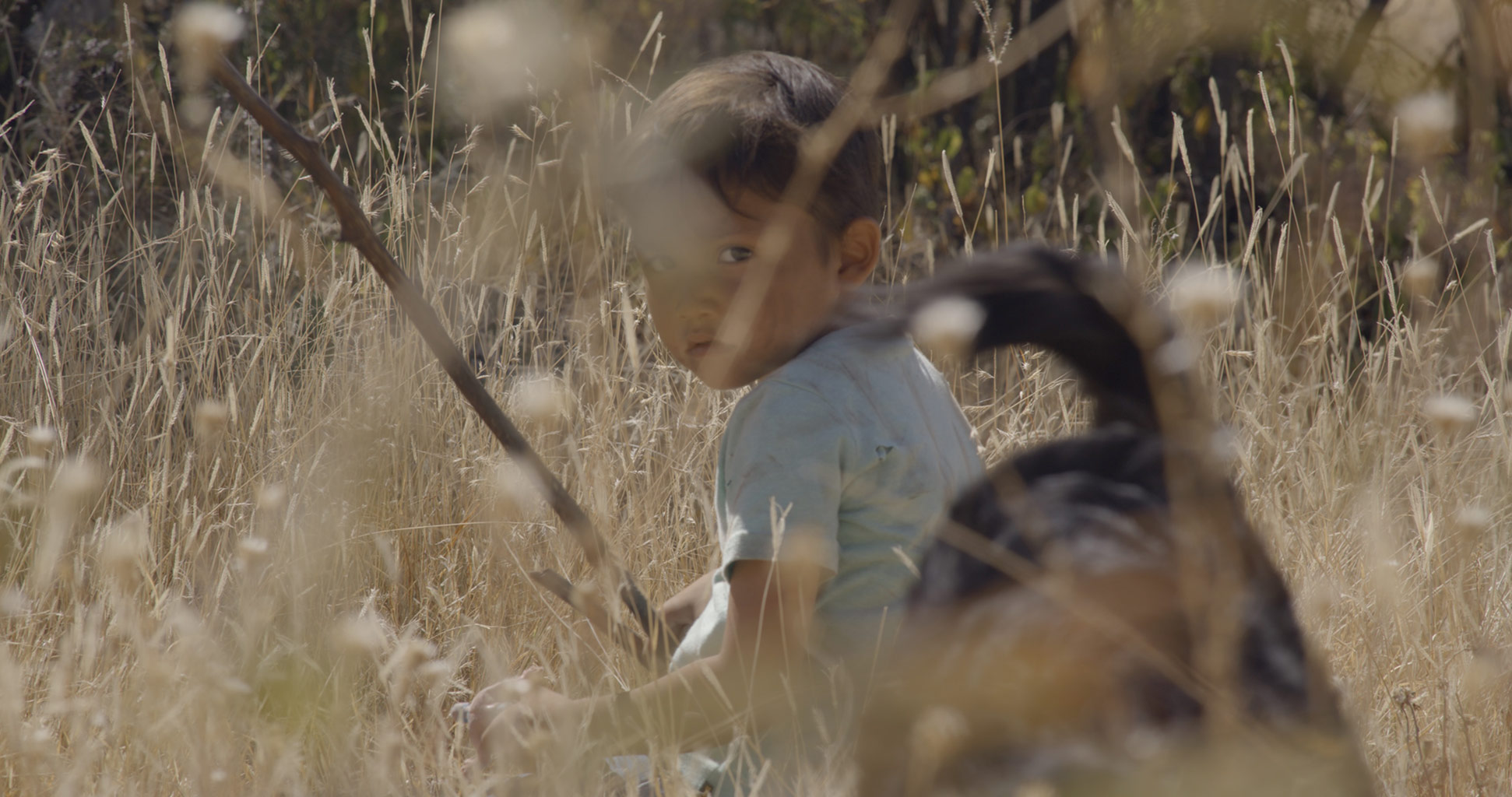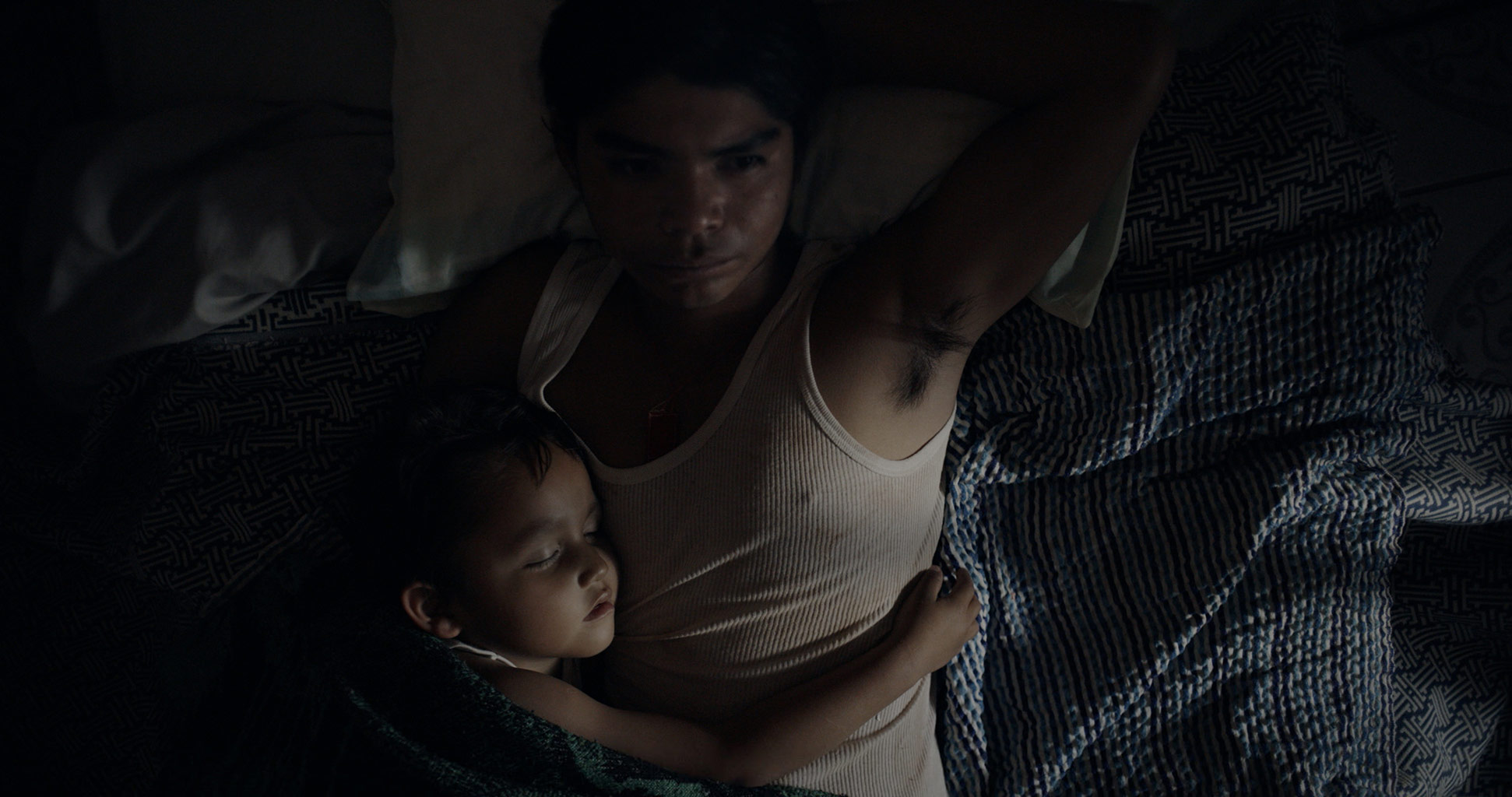
Masculinity Guided by Matriarchs
Named after its main character, Sujo is divided into five chapters that specifically follows Sujo’s journey from when he is a young boy to when he is a teenager, entering the wider world on his own. The first chapter is “Sujo” and covers the main character’s youngest years; the remaining four are named after family members, friends, and mentors who become central to Sujo’s life path.
At the start of the film, 4-year-old Sujo is orphaned in the countryside of Michoacán, located in central Mexico. A cartel member had just taken revenge on his traitorous sicario father, Josue, after Josue had betrayed and murdered a man close to him. To ensure that Sujo is not punished for his father’s misdeeds, Sujo’s aunt Nemesia requests leniency from a head cartel member – who begrudgingly allows Sujo to remain under the custody of his aunt under one condition: he is never to be seen in the main town.
Sujo grows up under the watchful eye of Nemesia, played by Yadira Pérez, but he also eventually learns to defy the cartel member’s initial orders. Over time, he becomes loosely initiated into the gang himself, and then eventually must escape it. Along the way, Sujo‘s life is greatly informed by the transformative power of matriarchs – even despite an ongoing drug war that is often riddled with machismo and toxic masculinity.
“We were excited but were worried also, that we could portray… a construction of masculinity and all the issues of masculinity,” explains Valadez. Valadez and Rondero, who have been working together since Rondero’s first short film, En Aguas Quietas (2011), have long felt “closer to female stories.”
Sujo is the duo’s first film to feature a male protagonist. During the screenwriting process, it was only natural that their story – which centered around the coming-of-age of a Mexican boy – also incorporated strong female characters. The filmmakers were influenced in part by the controversial phenomenon of personas desaparecidas, or unsolved missing persons cases which have plagued Mexico in recent years.
“In Mexico, it’s something we feel very close [to],” Valadez explains. “There are males, of course; there are sons and brothers, and but it’s mainly women who throw themselves [into] looking for justice, and very often, they become activists.”

Portraying Mystery Through Settings and Cinematography
Communicating through an expansive lyrical and poetic style, Sujo owes a large part of its success to its striking cinematography, which serves as a grounding throughline to a tale that is otherwise full of dynamically-shifting environments and emotions. That language was born from a tight-knit collaboration with cinematographer Ximena Amann, who the co-directing duo have been working with for years. Together, they created a visual language that is simultaneously grounded in reality and floating in dreaminess.
Twice in the film, for example, deaths are portrayed with the deceased moving in slow-motion, crossing wordlessly through naturalistic landscapes as they look directly into the camera. No verbal explanation is necessary for viewers to understand that the dead have passed onto another world. This visual motif, Valadez explains, came primarily from Romero’s imagination, but was executed together as a team and speaks to the film’s larger themes.
“When we were discussing and writing, what we also wanted to do was to have different points of views [on] time and reality. We wanted the film to change in those point of views that are not necessarily corresponding to only one character, but to one season of a life,” Valadez explains. “We wanted [the deaths] to feel like… the boy growing up and having this sense that the world is complex – and using all those devices to express… the mystery of the universe.”
The environment and animals are referenced numerous times throughout the project and help heighten the film’s sense of mystery. In one haunting scene, Sujo and Nemesia cross paths with a wild dog as night descends, but Nemesia reassures Sujo to have no fear. She simply describes the dog as a creature that “belongs to the cerro,” or mountainside, bringing a mystical quality to the everyday presence of animal life as significant players.
“[Relationships to animals are] shared among the cultures in Mexico… A general idea of how we feel [about] the world [is] that we are connected to the animals; that we are connected to nature,” Valadez says. “We wanted to express that through all our human endeavors and all the things that we deal with — our worries and violence, [we are still] contained in something that’s broader and goes beyond those.”
Lighting also played a primary role throughout Sujo and was deeply guided by cinematographer Amann’s vision. Sunlight and moonlight heighten the mystical qualities of people and animals; similarly, scenes with moonlight or dim lighting heighten key dramatic moments and build tension.
Valadez credits evolving technologies, fast camera lenses, and sensitive cameras as crucial to helping them pull off the look that they wanted. Using such tools, she explains, “[With] some particular scenes, we could shoot with moonlight… and when we couldn’t do that, we had to find a way in which to set the scene and to find… sources of light that would justify the lighting.”
When natural lighting was insufficient or inappropriate, the filmmakers made a rule to rely strictly on practical lighting, as opposed to adding additional lights to the set. Practical lighting thus involved the cast holding flashlights in their hands or driving cars and motorcycles – but the self-imposed limitations did result in some logistical and technical challenges.
One evening, young Sujo enters town with his two best friends and receives his first kiss from a girl. The three boys travel by way of running and riding motorbikes down dirt roads, but the scene had to be filmed twice to account for insufficient lighting the first go-around. The filmmakers shifted the blocking during the second attempt to utilize the headlights of the motorcycles more significantly.
“We shot that [scene] twice, because the first time they were walking without the motorbike… so we didn’t have a source of light…” Valadez recalls. “We shot it, and it didn’t look good, [so] we went back.”

Community Closeness and Community Care
Sujo was filmed in Valadez’s home state of Guanajuato, which borders the state of Michoacán, where the fictional story is set. Personal relationships and an intimate understanding of the region were vital to the success of the production, which was supported by people who have known Valadez practically her whole life. Also relevant was the fact that the filmmakers were quite familiar with the area; they had already scouted the rural areas outside of the main city center Guanajuato for other projects.
“We just continued to explore the places around those communities, and that gave us, I think, the advantage of using spaces that were just as we found them, but also building some others in those spaces and having like the best of both worlds,” explains Galadez. “[We had the] the realism of the spaces, and also [built] with that realism to our advantage.”
Among the production’s custom-crafted sets was the home of Nemesia, which the film translates as “Vengeance,” though the name’s origins come from Greek mythology. Nemesia’s home is described by cartel members as that of a bruja; crafted of dark wood and set in isolation, it possesses a cold, drafty feel every time it is seen at jnight.
Throughout Sujo, its filmmakers play with stereotypes Mexicans may have regarding male figures caught up in cartel violence, but they also hope to present such characters in sensitive and considerate ways. Part of how the characters are “held” in the film is in relation to the community around them, whether that be by mothers, aunts, educators, cartel members, or peers. The film demonstrates that relationships in small, violence-affected communities can be close-knit and caring, even despite the prevalence of illegal or dangerous behaviors.
“In general… there’s no clear division between victims and perpetrators. We can all be one or the other, depending on the circumstances…” Valadez shares. “All perpetrators — all these young men that in Mexico have turned themselves to violence — they were at some point kids, and so, they were innocent. They deserve that recognition that there’s something that we have done wrong in society for them to become who they are.”
One example can be seen in Josue, the troubled father of Sujo. Josue was a sicario who was killed for being a murderous traitor – but the few times he is seen with his son, he is tender, caring, and full of fatherly ambition. His character arc is complex, but such complexities are also relatively normal, according to Valadez. She shares that the filmmakers were inspired by the work of journalist Javier Valdez Cárdenas, who was eventually murdered for his reporting on cartels.
“[Javier Valdez Cárdenas] wrote extensively about young men going into violence, with direct accounts…” Valadez explains. “It’s so human and so understanding in a very deep way, I think, that [it] allowed us to rethink how we were approaching violence.”
In order to authentically tell the story of Sujo, the film relied on a host of nonprofessional actors from the local community. Among them was teenager Juan Jesús Varela, who played the lead character, Sujo. Jesús Varela has since discovered his passion for acting and is pursuing acting more seriously, despite not having a professional background.
“You cast non-professional actors because you may think [they’re] similar to the character, [and] they bring their humanity and their characteristics to get to the character,” says Valadez, who adds that productions outside of Mexico City generally work with non-professional actors.
Working with non-professionals can come with a degree of authenticity, but it also comes with its ethical concerns. Care can be especially necessary when working with people who come from communities that face great adversity or are not well-resourced.
“When we were working as assistant directors, we felt some productions use those boys or those girls, like: we cast you for film, we use you and then we discard you. And there are cases of films that went [to] big festivals and made money, but those kids remain in their communities,” Valadez comments. “It was a challenge of how we should approach that so it was a positive experience. We couldn’t offer that we would change their lives, because that’s not in our hands – but we could offer an experience that would be meaningful, hopefully, and just proportional to what they were giving us.”
In the latter part of the film, Sujo is forced to leave his hometown and finds his way to Mexico City, where the conditions of survival and landscapes of the city are far removed from the wilds of the countryside. There, he takes on his first meaningful employment, finds secret ways to educate himself, and otherwise scrapes out a living in a new city where he knows no one.
Sujo’s journey seems lonesome and difficult after his departure. But by tracking his journey through multiple perspectives of those important in Sujo’s life, the film raises important questions about what it takes for a young man to survive after a lifetime dictated by violence and drug cartels.
“When we have shown this [film or script] to some [Mexicans], I think we realized… to use the prejudice of the viewer as a narrative device,” says Valadez, who notices that Mexican viewers often expect Sujo to make the worst choices possible. “It’s like: this kid is not going to make it. This kid is gonna rob the teacher. This kid is going to become the same as his father.”
Through Sujo, Valadez and Rondero might simply be asking some of the questions that many onlookers are thinking. Do these children and men have a choice in the controversial decisions that they make? Or are they merely trying to survive?
“This crisis has just lengthened throughout the years,” comments Valadez. “I think we, as Mexicans, keep thinking: how are we going to get out of this?”
Yet despite the darkness, poverty, and violence sometimes faced by those affected by the drug trade, Sujo does somehow manage to offer some respite – which can exist in family, friendship, dreams, and the beauty of the natural world.
Sujo Film Trailer
Ω






